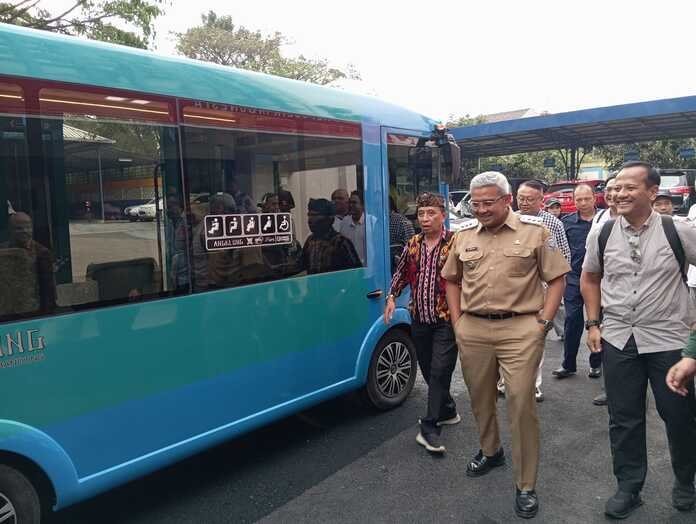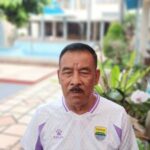BANDUNG – Dismissing rumors about committing to purchase prototype vehicles for public transportation development, Bandung Mayor Muhammad Farhan clarified that recent reports were inaccurate and potentially misleading.
“I must clarify that Bandung City Government has never committed to purchasing those prototype vehicles. This was purely an initiative by entrepreneurs,” Farhan stated during a visit to Gedebage.
He explained that the vehicles in question were merely prototypes, not part of any official procurement. No decisions have been made regarding purchase, replacement, or operation.
“We haven’t reached the vehicle replacement planning stage yet. We’re still developing the concept for an integrated public transportation system,” he said.
Farhan emphasized that public transport owners and drivers would remain involved in developing the integrated system, mentioning cooperatives like Kopamas and Kobanter as early discussion participants.
“We consistently involve public transport cooperatives. This can’t be done unilaterally. All stakeholders, including operators, must participate,” Farhan explained.
He denied claims that cooperatives were excluded from planning new systems like Bus Rapid Transit (BRT), calling such reports hoaxes.
“Reports about vehicle purchases or excluding cooperatives are false. Don’t spread them. We’re inviting all parties to jointly plan Bandung’s transportation future,” he said.
Regarding mass transit development, Farhan stated Bandung would focus on two main corridors: east-west and north-south. The east-west route would prioritize BRT as the public transport backbone.
Traditional minibuses (angkot) won’t be eliminated but will undergo transformation to adapt to the integrated system.
“Minibuses will remain but can’t continue operating as they do now. They must evolve with our integrated system,” he said.
Farhan clarified the government wouldn’t take over transport operators’ roles but would remain the regulator, with operators maintaining their central role.
“I’m not an operator but a regulator. Technical matters will be discussed with operators, cooperatives and drivers – they’re the experts,” he added.
The Mayor underlined that Bandung’s transportation policy aims for an integrated, inclusive and sustainable system, with equal participation for all stakeholders in this transformation.
“We won’t take shortcuts. We’re building a comprehensive system through collaboration. All parties have a place in Bandung’s transportation future,” he concluded.
Bandung City Government
The Bandung City Government oversees Indonesia’s third-largest city, known for its colonial heritage, vibrant culture, and educational institutions. Established during Dutch colonial rule in the early 19th century, Bandung became a key urban center and later a symbol of Indonesian independence and modernization. Today, the city government promotes sustainable development, tourism, and technological innovation while preserving its historical landmarks.
Gedebage
Gedebage is a district located in the eastern part of Bandung, Indonesia, known for its historical railway station and growing urban development. The area has transformed from a primarily rural region into a more industrialized and residential hub, partly due to its strategic location near major transportation routes. While not a major cultural site, Gedebage reflects Bandung’s expansion and modernization over the years.
Kopamas
“Kopamas” does not refer to a widely recognized cultural site or place in historical or contemporary records. It may be a misspelling or a lesser-known local term. If you meant a specific location or cultural site, please provide additional details for a more accurate summary.
Kobanter
“Kobanter” does not refer to a widely recognized cultural site or place in historical or contemporary records. It may be a misspelling or a lesser-known local term. If you meant a specific location or cultural reference, please provide additional details for a more accurate summary.
Bus Rapid Transit (BRT)
Bus Rapid Transit (BRT) is a high-capacity public transportation system designed to provide fast, efficient, and affordable urban mobility using dedicated bus lanes, off-board fare collection, and priority at intersections. First implemented in Curitiba, Brazil, in 1974, BRT systems have since been adopted in cities worldwide, including Bogotá (TransMilenio) and Jakarta (TransJakarta), to reduce traffic congestion and emissions. Combining the flexibility of buses with the efficiency of rail systems, BRT is a cost-effective solution for improving urban transit.
east-west corridor
The **East-West Corridor** is a major urban and transportation region in Trinidad and Tobago, stretching about 25 miles between the capital, Port of Spain, and the city of Arima. Historically, it developed along the path of an old railway line and is now the country’s most densely populated area, serving as an economic and cultural hub. The corridor is known for its mix of residential, commercial, and industrial zones, as well as landmarks like the University of the West Indies and the iconic Queen’s Park Savannah.
north-south corridor
The **North-South Corridor** is a major infrastructure project in Singapore aimed at improving transportation connectivity between the eastern and western regions of the island. Originally conceptualized in the 1990s, it includes a 21.5-kilometer expressway and cycling paths, designed to ease traffic congestion and promote sustainable travel. The project reflects Singapore’s long-term urban planning efforts to enhance mobility and reduce environmental impact.
angkot
Angkot (short for *angkutan kota*, meaning “city transportation”) is a popular form of public minibus transportation in Indonesia, particularly in cities like Bandung and Jakarta. Originating in the mid-20th century, these colorful, shared minivans operate on flexible routes, picking up and dropping off passengers along the way. Angkot reflects Indonesia’s informal transport culture and remains an affordable, though often crowded, option for daily commuters.






